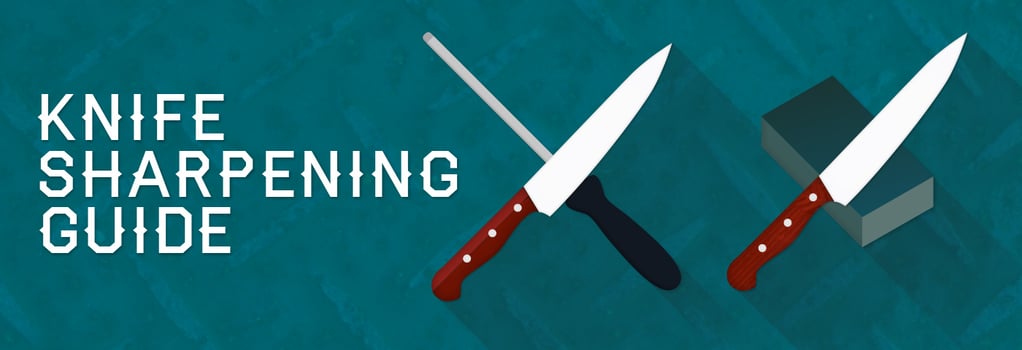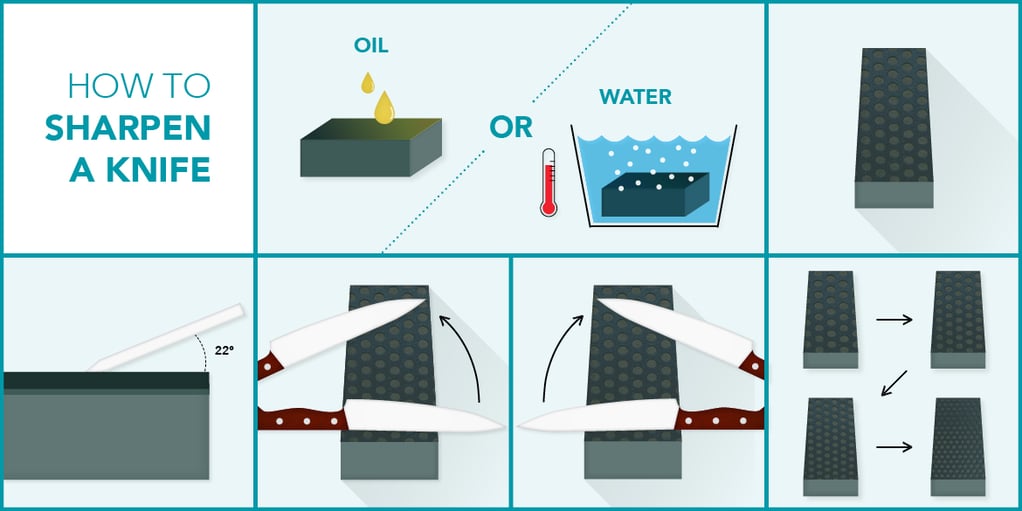Knife Sharpening Guide

A dull knife is a dangerous knife – it requires more pressure to push through food and is therefore more susceptible to slipping, sending the blade out of control and possibly into a nearby hand. Keeping your knives sharp keeps food prep faster, easier, and safer. There are several schools of thought on which knife-sharpening method is best, so we will touch on each option and let you decide which is right for you.
Table of Contents
Knife Sharpening Services
The first and arguably easiest option is to send your knives to a knife sharpening service. These services charge a fee, usually determined by the size of the knife, and while knife sharpeners used to be mobile — traveling in trucks and sharpening wherever they went — modern knife sharpeners have abandoned that practice. To make use of one of these services today, you must either find a local sharpener or be willing to ship your knives across the country. This option has the drawback of expensive knives potentially being lost in the mail, as happened to reporters at The Wall Street Journal during their knife sharpeners service review.1
Another drawback of these services is the cost. Professional chefs need their knives sharpened several times a year, so the costs of having it done by a knife sharpening service can add up quickly. Not only that, but in most cases you will be without your knives for a week or two. If you decide to try this option, it is important to know if your knives are Western (German) or Japanese, as the sharpening requirements vary between the two. If you have Japanese knives, be sure to ask if the service has experience with those and, if possible, read the reviews left by other Japanese knife owners. Sharpening a Japanese knife in the Western style can ruin the blade and be difficult to recondition.
Honing

Whether you decide to sharpen your knives yourself or use a sharpening service, it pays to own a honing steel, also called a steel or honing rod, and to learn how to use it properly. Please note that it is not recommended that you use a honing rod on Japanese blades; for those, skip down to the next section to read up on waterstones.
Honing does not actually sharpen the blade, but realigns it. During regular use, the sharp edge of the blade will fold over in small, microscopic segments, meaning you end up cutting with the dulled, rolled-over edge, rather than the actual edge that is still sharp. A honing rod stands up the rolled-over portion and brings the sharp edge back to where it can be used. Proper and regular use of a honing steel can extend the time between required knife sharpenings. Honing should be done once a day with regular use, or several times throughout the day with heavy usage.
When you begin shopping for a honing steel, take stock of your knives and measure the longest one you will be honing. You will need a steel two inches longer than your longest knife, and preferably one with a comfortable handle and a hand guard for safety. While you may have seen experienced chefs whipping their knife down the steel on television, when you are first starting out it is important to learn how to use the tool and get used to holding the knife at the proper angle. To get started using your honing rod:
- Stand the rod straight up on its tip on a folded towel on a counter or other sturdy surface, gripping the handle firmly with your non-dominant hand. Hold the knife you plan to sharpen in your dominant hand, sharp side down
- Place the heel of the blade against the steel and tilt the spine away at a 20-degree angle. To help get the angle correct, try holding the blade at a 90-degree angle to the steel (perpendicular), then cut that in half to make 45 degrees, then halve that to make 221⁄2 degrees. This brings you very close to the 20-degree angle you need, so you can just draw the spine of the knife a bit closer to the steel to get the correct angle.
- Starting at the heel of the knife, draw the blade down the rod and toward you. The end of your stroke should bring the tip of the blade to the bottom end of the rod. Do not press too hard – you will only need to provide slightly more pressure than the weight of the knife provides.
- Repeat this stroke two to three times on each side of the blade.
If you complete these steps and the edge of your blade does not seem to have improved, check that you were using the correct angle, and try again using a bit more pressure. If there has still been little improvement, your blade is likely beyond the help honing can provide, and instead needs to be sharpened.
Sharpening

While most knife enthusiasts can agree on honing techniques, when it comes to knife sharpening there are nearly as many opinions as there are knives. Some of the confusion comes from misuse of terminology, so we will cover some definitions first.
- Swarf: Slurry of tiny pieces of metal and stone that develops as a knife is sharpened on a stone.
- Whetstone: Any stone, natural or manmade, used to sharpen a knife. 'Whet' means "to sharpen by rubbing on or with something"2, and does not refer to whether the stone should be wet or dry.
- Waterstone: Sharpening stone of Japanese origin that must be soaked and kept wet during use, as the water enables the knife's edge to create a 'mud' with the stone shavings that helps grind the edge down. Waterstones are generally believed to be faster and produce a more high-quality edge than oilstones. These are the only sharpening stones that should be used with Japanese blades, as the steel is more brittle and the softer waterstones sharpen them more gently.
- Oilstone: Traditional Western sharpening stone that can be used dry or with oil, but is generally believed to work better with oil as it prevents the swarf from filling the tiny crevices in the stone and creating a glazed surface that is too smooth to sharpen effectively. These sharpen slower than waterstones and create more of a mess due to the oil, but are cheaper and don't require soaking before use. They also don't wear down as quickly as waterstones, so they do not require flattening.
Be aware that sharpening your knife will entail removing a small amount of the metal from the blade, so the more often you sharpen, the shorter the overall life of your blade will be. Only sharpen your blade when honing no longer succeeds in bringing back a sharp edge. To sharpen your blade with a whetstone:
- Prep your stone as needed. Oilstones will require a few drops of oil on the surface. Waterstones should be soaked in a tub of water until bubbles stop escaping, and have a container of water nearby so you can continue adding water to the stone throughout the sharpening process.
- Place the stone on a flat, nonskid surface such as a rubber mat or wet paper towel. If your stone or stone set has multiple grits on different sides, start on the coarsest grit.
- Place the heel of the blade against the stone at a 20- to 22-degree angle for Western blades or a 10- to 15-degree angle for a Japanese blade (only to be sharpened on waterstones).
- Slide the blade forward across the stone from heel to tip, maintaining the angle for the entire stroke. The stroke should cover as much of the stone as possible, in a motion as if you were slicing a thin layer off the top of the stone. Try to use the whole stone to prevent uneven wear.
- Repeat this stroke 10 times, rotating the stone halfway through to promote even wear.
- If using multiple grits, repeat steps three through five for each grit from coarsest to finest.
Another option for sharpening are sharpeners that use ceramic discs to create a fixed angle. These are convenient for those who find whetstones intimidating or too time-consuming. These knife sharpeners may be countertop or handheld models and can be motorized or not. Whichever is the case, the blade of the knife should be placed in the slot and drawn back toward you for several strokes until the knife is sharp. If the sharpener has several sets of discs, start with the most coarse and move down to the finest.
No matter which sharpening method you use, be sure to test the knife to make sure your work is done. A common kitchen test is to see how easily the blade can slice through a piece of newspaper. Also, be sure to wash the knife before using it with food, as the metal and stone fragments on the blade can cause a health hazard.
- Do Knife Sharpeners Make the Cut? The Wall Street Journal. Accessed December 2015.
- Whet. Merriam-Webster. Accessed December 2022.
